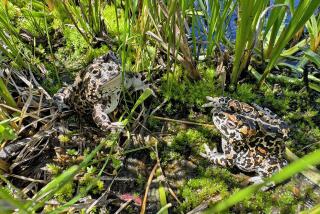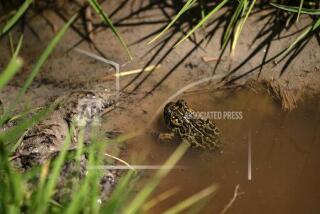Rare Toad Disrupts Tanzanian Dam Construction
- Share via
KIHANSI, Tanzania — Under the muffled roar of water and a steady mist, the rare Kihansi spray toad has thrived high in a remote gorge, blissfully unaware of the turmoil its discovery has caused among environmentalists, World Bank officials and electricity-starved Tanzanians.
Nearby villagers believe that the unique, thumbnail-size creature has magical powers and that their future is directly tied to the toad, whose scientific name is Asperginus nectophrynoides.
World Bank officials are concerned about an environmental backlash if the new $272-million hydroelectric dam the bank has co-financed with Norway, Sweden, Germany and the European Development Bank so drastically alters the habitat that it wipes out the 11,500 toads.
But through an innovative four-year project to breed the toads in zoos in the United States, Tanzanians may get the electricity they desperately need and save their unique amphibians in the bargain.
Until the dam was built, the Kihansi River in the southern Tanzanian highlands rushed over an escarpment, plunging onto massive boulders below, sending up a spray in which the lime-colored toads with dark yellow patches flourished, unknown to the world outside.
The species, unique to the 3-mile by 1/2-mile Kihansi gorge, is unusual among toads because it does not lay eggs but gives birth to live toadlets. It was discovered by University of Dar es Salaam Professor Kim Howell in 1996 during an assessment conducted after concern was raised about the dam’s environmental impact.
Howell said the toads live among thick undergrowth and moss-covered rocks within a narrow strip of a tropical forest bordering the gorge. The area was inaccessible until 1996.
“We hear rumors of mysterious toads who give birth to live young . . . close to the source of Kihansi River,” said Steven Kibiki, 32, a security guard from a village where people live on less than a dollar a day.
“They are most likely the spirits of the river, and some disaster may befall this area and the river itself if they are somehow wiped out,” he said, looking in the direction of the mist-covered escarpment.
But the upstream construction of Tanzania’s largest hydroelectric dam, completed in 1999, greatly reduced the flow of water into the gorge below, shrinking by 95% the area hit by spray.
Responding to concerns from environmental organizations, the World Bank coordinated discussions on conservation measures and agreed to a Tanzanian request for assistance in coming up with a plan to save the toads, said Jean-Roger Mercier, the bank’s Washington-based lead environmental specialist.
Only two of the three projected 60-megawatt turbines were commissioned between last December and May to preserve what remained of the toad’s habitat, despite nationwide power rationing after reserves in other dams dwindled to dangerously low levels after two years of drought.
Electricity produced by the dam is vital for economic growth in Tanzania, where expanding industrial needs and increased domestic consumption have pushed demand for power in the East African nation to more than 550 megawatts. The national grid currently puts out between 225 and 416 megawatts.
Mercier said discussions identified three alternatives to save the toads. One, relocation in Tanzania, was considered too risky because there has only been a 20% success rate with transferring toads and frogs to new habitats. He said captive breeding was extensively discussed, but Tanzania was reluctant to export the species.
While discussions were in progress, 2,145 feet of pipe were installed below the dam to sprinkle about two cubic meters of water per second on the toads--enough to generate 15 megawatts of electricity worth $2 million a month.
But without a backup system, the artificial spray often fails to work when silt blocks the pipes’ fine nozzles, and a study by environmental consultant John Gerstle indicated seven and not two cubic meters of water would be necessary to maintain the quality of the gorge ecosystem and its associated forest.
“There was a very clear need for an emergency measure,” Mercier said. And it was met pro bono by the Wildlife Conservation Society of New York’s Bronx Zoo to set up the captive breeding program.
On Dec. 1, 500 toads arrived safe and sound at New York’s Bronx Zoo after an uneventful flight from Dar es Salaam via Amsterdam.
Some will remain in the Bronx, while others will find a home away from home at zoos in Detroit, Oklahoma City, Chicago, Baltimore and Toledo, Ohio.
Part of the estimated $90,000 project involves training Tanzanians in toad conservation.
“The toads sent to the United States are our insurance policy in case those remaining at Kihansi are somehow wiped out during our search for a suitable alternative habitat in another part of Tanzania,” Philemon Luhanjo of the Ministry for Natural Resources and Tourism said. “But ownership of the 500 toads remains ours 100%, all the time.”
Although Luhanjo said the government had set a four-year deadline on finding the toads a new habitat in Tanzania, he acknowledged that they might end up staying much longer in the United States.
Electricity-starved Tanzanians are bewildered by the agitation over a tiny species.
“No one in this village has seen the toad, but I fail to see why we have to go without electricity because of them,” businessman Seba Kisamo said while supervising the loading of bags of maize onto a truck.
Tanzania may still have to pay a stiff environmental price because of efforts to save the toad.
Olav Vallevik, an engineer with the Norwegian firm Norplan that built the power plant, said Tanzania would have to burn 350,000 tons of fuel--imported diesel and rapidly diminishing firewood--per month to produce the same amount of power that would have been produced by the water used in the artificial spray system to preserve the toad habitat.
More to Read
Sign up for Essential California
The most important California stories and recommendations in your inbox every morning.
You may occasionally receive promotional content from the Los Angeles Times.













